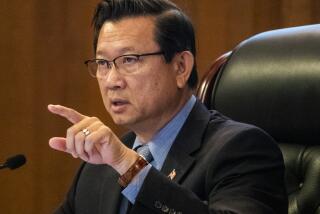Auditor’s Role in Fund Diversion Under Scrutiny
SANTA ANA — Investigators for the district attorney and county supervisors are questioning what role Auditor-Controller Steve E. Lewis may have played in the improper diversion into a little-known county account of $85 million belonging to other participants in the county’s now-collapsed investment pool.
Lewis confirmed Wednesday that he was interviewed by district attorney’s investigators for two hours last week, and that one of his top assistants was questioned this week. He declined to disclose details of the inquiry but defended his handling of the matter.
Lewis’ office handles all cash transfers between accounts maintained by the various county departments, and he was specifically directed by the Board of Supervisors to shift what turned out to be $125,805,822 in “extraordinary interest earnings” into its Economic Uncertainty Fund.
Lewis said Wednesday he “had no reason to question (the transfers) when the county administrative office was working so closely with the treasurer on it.”
He said he was repeatedly assured by then-Treasurer-Tax Collector Robert L. Citron and members of the county administrative office, including then-budget director Ronald Rubino, that the money flowing into the two funds came merely from county investments.
At least $85 million--and possibly as much as $100 million--of the total should have been credited to the investment pool accounts of the other 186 cities, school districts and special districts that had entrusted funds to the county, officials now say.
Instead, it was transferred into the uncertainty fund, which county supervisors established in 1985 for emergency uses, and into account “9JJ,” a holding account with no designated beneficiary. The 9JJ fund had held as much as $15.3 million, finance officials said.
Since the fund diversion was discovered and announced last weekend, the county’s administrative officer was demoted, the finance director and assistant treasurer were placed on paid leave and investigators from the district attorney’s office have focused their efforts more closely on the improper shifting of funds, seeking to determine whether government records were falsified and if county officials mislead investors in the pool by shortchanging their interest payments.
Rubino, who with former County Administrative Officer Ernie Schneider is generally credited with devising the plan to use surplus interest earnings to help make up for reductions in property tax revenue, declined comment Tuesday. Schneider has said he was “stunned” to learn that the money belonged to other investment pool participants and had no idea that it had been improperly diverted.
In interviews this week, four county supervisors also raised questions about Lewis’ involvement in the transfers. They said they want to know why Lewis, who has taken credit for being among the first to signal problems with Citron’s office in a critical 1991 audit, didn’t more fully investigate the source of the money, and sound an alarm last spring when the transfers occurred.
The improper diversions, as things turned out, were not made public until an outside accounting team from Arthur Andersen & Co., along with Jim Mercer, an attorney representing the county in several lawsuits, finished tracing all of the transfers last Friday.
Supervisor Marian Bergeson said the county needs to conduct job performance “evaluations” of Lewis and other employees to determine who was responsible for the oversight. “That’s where I have personal questions,” Bergeson said. “I can’t imagine figures weren’t monitored. . . . Who’s watching the store? Maybe there was too much trust in Citron.”
Supervisor Jim Silva said he wants the auditor’s role fully examined, as did Supervisors Gaddi H. Vasquez and Roger R. Stanton.
“The entire paper trail needs to be evaluated by the district attorney and the Securities and Exchange Commission,” Silva said. “I’m very concerned about the situation.”
Critics claim that the auditor-controller should have kept a separate set of books parallel to the treasurer’s as a way to reconcile any discrepancies.
“It would appear to me that the auditor-controller’s office has utterly failed” in one of its primary tasks, said William Snow Hume, a Fullerton accountant who is looking into Lewis’ role in the financial crisis for the Ross Perot-backed taxpayer group, Committees of Correspondence.
Hume said the organization will discuss whether to launch a recall movement against Lewis at its meeting next week.
“Either they weren’t doing their job, or they knew what was going on and they weren’t communicating it,” Hume said.
“By law, they had to know about it,” Hume said of the interest diversion. “If they didn’t know about it, then the entire auditor-controller’s office should resign right now.”
Even though his office regularly audits the treasurer’s operations, Lewis said it is impossible for his office to catch every county indiscretion with his limited resources. “With only 15 auditors, it’s not like we’re there everyday,” Lewis said. “We’d like to be able to audit a place once every three years.”
Lewis’ last audit of the treasurer’s office was conducted in 1991, but supervisors were not given the results of the audit until 1993.
Lewis said he twice has asked the county’s outside auditor, the Big Six accounting firm KPMG Peat Marwick, to review Citron’s practices. Specifically, he said he asked the firm to look into the Economic Uncertainty Fund.
Peat Marwick’s 1994 audit, which was due about the time the county declared bankruptcy, has never been made public, and the firm’s 1993 audit did not signal any major problems with the treasurer’s office. The firm insists that it has never been expected to pass judgment on the types of investments that landed the county in trouble. The county pool collapsed in part because rising interest rates rapidly eroded the value of Citron’s investments in risky, leveraged securities.
“Our audit shows that the 1993 (Orange County) financial statements were fairly presented and in accordance with government accounting principles. What got Orange County into trouble was its investments, not its accounting,” said John R. Miller, a top New York-based official of the accounting firm.
Lewis said he began to suspect that some of the transferred funds belonged to other cities, schools and special districts when former Assistant Treasurer Matthew Raabe told Lewis and other county officials more than six weeks ago that some of the money in the “uncertainty fund” was restricted and could not be used to help bail the county out of bankruptcy.
Sometime after Raabe’s vague remarks about restrictions on the fund, county officials asked Arthur Andersen & Co. to take a look at the account. Last week, they announced that the fund transfers were improper diversions of money belonging to other investment pool participants.
Alan T. Sasaki, auditor-controller for Los Angeles County, said his office keeps a close eye on “all of the transactions in and out of . . . accounts” it handles for the Los Angeles County Board of Supervisors and other county departments there.
“We try to understand what source is the money coming from, and what will be the uses of that money,” Sasaki said. “Then we monitor all of the funds to make sure that we can reconcile and balance all of the transactions.”
“We review the accounts periodically,” he added. “We look at the account and say, ‘Hey, the amount in the account is really growing, I think we need to do something. . . . ‘ It sometimes gives us a clue that we ought to check it out.”
Sasaki said he had no first-hand knowledge of the Orange County situation. But “from what we’ve read” of the interest diversion, he said, “I think it’s something we would have looked into or at least questioned.”
Orange County Supervisor William G. Steiner said he is concerned about what Lewis may or may not have known about the diversion issue, but said that Lewis’ past audits--which were critical of the treasurer’s operations--indicate that the auditor was not afraid to point out irregularities.
“Did he blow it now?” Steiner asked. “It would be inconsistent in light of the red flags he diligently raised in previous audits.”
Arthur Greenberg, Lewis’ attorney, downplayed his client’s role in the interest diversion, saying that the treasurer or the supervisors create funds and the auditor is merely “a bookkeeper.”
“The auditor is aware of the existence of a fund after it has been created, and the auditor’s office, which consists of 450 people, is aware of the daily balance of every fund, and is aware of any transfers among the funds,” Greenberg said.
“The auditor’s job is not to approve or disapprove of transactions, but to record what is done. Every transaction is not known intimately by the auditor in chief. It’s known by his office,” Greenberg added.
State law defines the auditor-controller’s role as “the chief accounting officer of the county,” and says the auditor is responsible for “the accounting forms and the method of keeping the accounts of all offices, departments and institutions under the control of the board of supervisors and of all districts whose funds are kept in the county treasury.”
Donald Sorenson of Inyo County, vice president of the State Assn. of County Auditors, said that means the auditor is responsible for keeping track of daily balances in all funds deposited with the treasury, as well as all incoming and outgoing money and all transfers between accounts.
“Normally the auditor is going to have the detail as to each fund, and the treasurer is going to have the big picture of total dollars,” Sorenson said. “The auditor should know what the balance is (of every fund). He should know how quickly it’s growing.”
Though Lewis has hundreds of employees who probably handle routine transfers among funds, Sorenson said: “Each of us (auditors) is ultimately responsible.”
More to Read
Sign up for Essential California
The most important California stories and recommendations in your inbox every morning.
You may occasionally receive promotional content from the Los Angeles Times.









